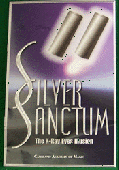Silver Sanctum
Matlin, Phil
Camirand Academy of Magic
(Based on 1 review)

Reviews
(Top ▲)
Originally released in the late 1970s, Phil Matlin's Silver Sanctum has recently been reissued by The Camirand Academy of Magic.
A spectator is handed two identical cylinders and directed to put one in his left pocket and the other in his right (he can also put each of them under an opaque cup on the table so everything stays in reasonably full view). The magician then turns his back on the audience and asks the spectator to remove one of the cylinders, open it, place a paper match inside, close it, then return it to his pocket. The spectator does so, stealthily and silently, whereupon the magician turns back around and is able to divine unfailingly which pocket contains the cylinder with the match.
This is a devious and cunning effect, and I have no doubt it would fool you if you saw it performed. It employs a unique method that was independently developed by Phil Matlin and Lubor Fiedler in their respective countries around the same time. Lubor's routine has since been marketed by a German manufacturer, and Phil's effect has been re-released over the past two-and-a-half decades by various dealers under the name Brass Sanctums, then later, The Sorcerer's Stone.
This, however, is the original routine, with some structural input by Gary Ouellet and Guy Camirand, and it stands tall as an inexplicable feat of mentalism.
David Acer
A spectator is handed two identical cylinders and directed to put one in his left pocket and the other in his right (he can also put each of them under an opaque cup on the table so everything stays in reasonably full view). The magician then turns his back on the audience and asks the spectator to remove one of the cylinders, open it, place a paper match inside, close it, then return it to his pocket. The spectator does so, stealthily and silently, whereupon the magician turns back around and is able to divine unfailingly which pocket contains the cylinder with the match.
This is a devious and cunning effect, and I have no doubt it would fool you if you saw it performed. It employs a unique method that was independently developed by Phil Matlin and Lubor Fiedler in their respective countries around the same time. Lubor's routine has since been marketed by a German manufacturer, and Phil's effect has been re-released over the past two-and-a-half decades by various dealers under the name Brass Sanctums, then later, The Sorcerer's Stone.
This, however, is the original routine, with some structural input by Gary Ouellet and Guy Camirand, and it stands tall as an inexplicable feat of mentalism.
David Acer








